Gotha
![]()
The title of this article is ambiguous. For other meanings, see Gotha (disambiguation).
Gotha is the fifth largest city in the Free State of Thuringia and the county seat of the Gotha district. Gotha was the residential town of the Duchy of Saxony-Gotha-Altenburg from 1640 to 1825 and the capital and residential town of the Duchy of Saxony-Coburg and Gotha from 1826. In 1820 the German insurance industry was founded in the city with the Gothaer insurance company. In 1875, the Socialist Workers' Party of Germany (SAP), which later changed its name to SPD, was founded in Gotha's Tivoli. The city was a center of German publishing, so the publishing house Justus Perthes, founded in 1785, mainly cartographic publications (maps, atlases, wall maps, etc.) were produced.
In the past, the medium-sized town of Gotha was in rivalry with Weimar, the other centre of the Ernestine dynasty. While Weimar became the artistic centre, Gotha became its natural science counterpart, as witnessed today by the Natural History Museum and the Gotha Observatory, among others. The baroque Friedenstein Palace dominates the townscape. It was the residence of the Dukes of Saxe-Gotha-Altenburg until 1825, and from then until 1918 of those of Saxe-Coburg and Gotha.
A larger company from Gotha was the Gothaer Waggonfabrik, which produced mainly trams and aircraft. Today, Gotha is home to the Gotha tramway and the Thüringerwaldbahn, one of the last interurban tramways in Germany (to Waltershausen and Tabarz).
Gotha is the seat of the Thuringian University of Applied Sciences for Public Administration; two of the three departments are located here.

Panorama Gotha, panoramic view from the Margarethenkirche in direction of the western part of the town
Geography
Geographical position
The city lies at the transition of the southern edge of the Thuringian Basin to a foreland region of the Thuringian Forest, which is called the West Thuringian Mountain and Hill Country.
The urban area extends between the Trügleber Höhe, the Boxberg and the Kleiner Seeberg on an area of over 6900 ha. The Krahnberg in the northwest forms the highest point in the urban area with 431.3 m above sea level. The lowest point is 269.4 m above sea level in the Heutal.
Nature area
The city and its surrounding area are embedded between the Thuringian Forest and its foothills in the south and the forested ridge of the Fahnersche Höhen in the north in the scenically varied area of the Thuringian Basin, which is characterised by agriculture.
The largest elevations are the Krahnberg (431 m) and the Kleine and Große Seeberg (406 m). They extend to the built-up area of the city in the northwest and southeast. They were afforested in the 19th century as urban recreation areas and, together with the Schlossberg (331 m), which rises in the city centre, they form the natural foundation of the city.
The castle complex on the Schlossberg, visible from afar, dominates the townscape. The old town on the northern slope of the Schlossberg is bordered by the floodplains of the Wiegwasser in the west and the Wilden Graben or Flutgraben and the Ratsrinne in the east.
Waters
The Flutgraben flows through the city from south to north. The Rot, a tributary of the Apfelstädt, rises in the district of Siebleben. In Gotha-North the Wiegwasser runs through the city area. It is a small brook, which takes up the water flowing off from the Krahnberg. It rises about 100 m west of the end of Werner-Sylten-Straße and is led, partly underground, to the vicinity of Hersdorfplatz, where it joins the Wilden Graben shortly after it has absorbed the Leinakanal.
Neighboring communities
Adjacent communities are Nessetal in the north, Friemar, Drei Gleichen and Tüttleben in the east, Emleben, Georgenthal in the south and Hörsel in the west. All municipalities belong to the district of Gotha.
City breakdown
| City district/village | Area | Inhabitants 2004 | Inhabitants 2010 | Inhabitants 2016 |
| Middle | 1,02 | 4.605 | 4.733 | 4.854 |
| North | 8,42 | 3.957 | 3.983 | 3.806 |
| East | 10,80 | 3.921 | 3.460 | 3.717 |
| East Town | 1,45 | 3.856 | 3.939 | 4.219 |
| South | 7,06 | 4.035 | 4.160 | 4.217 |
| West | 3,13 | 10.119 | 8.993 | 9.424 |
| West Town | 1,56 | 7.256 | 7.052 | 7.256 |
| Gotha (core city) | 33,44 | 37.749 | 36.320 | 37.493 |
| Boilstädt | 4,02 | 884 | 867 | 811 |
| Siebleben | 12,56 | 5.394 | 5.180 | 5.065 |
| Sundhausen | 11,94 | 1.576 | 1.435 | 1.363 |
| Uelleben | 7,37 | 777 | 727 | 736 |
| Gotha (total) | 69,53 | 46.380 | 44.529 | 44.468 |
Source: Gotha Municipality, data as of 31 December of each year, main residences
In addition to these districts, the two villages Kindleben and Töpfleben, which were resettled in modern times and abandoned in the Middle Ages, belong to Gotha.
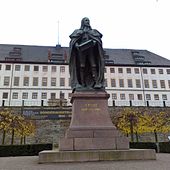
Monument "Duke Ernst the Pious
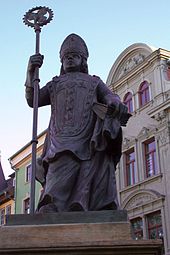
The Gothardus Fountain
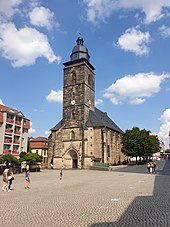
Margarethenkirche

Friedenstein Palace with the monument to Ernst the Pious
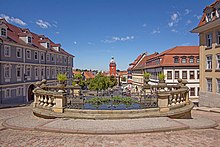
View from the Schlossberg over the Wasserkunst to the upper Hauptmarkt with the old town hall
Culture and sights
See also: List of cultural monuments in Gotha and List of Stolpersteine in the district and city of Gotha
Theatre
In the west wing of Friedenstein Palace is the Ekhof Theatre, the oldest completely preserved palace theatre in the world with original baroque stage machinery.
Gotha's municipal theatre, a neo-classical theatre building designed by Karl Friedrich Schinkel and Gustav Eberhard, was located on the eastern edge of the city centre on Theaterplatz (since 1991 Ekhof-Platz). The building burned out in 1945 due to the effects of war. The ruins were blown up in 1958, although the theatre could have been rebuilt. Until the spring of 2011, a memorial stone erected by the Old Town Association at the former site was a reminder of the venue.
Gotha's Kulturhaus hosts events throughout the year. Today's Kulturhaus was originally built as a cinema and opened in 1940 with the operetta film "Rosen aus Tirol". Used as a cinema until 1972, a year-long rebuilding phase followed. With a new boiler house, stage house, theatre café and modernised interior, it was reopened in 1973 as a district culture house. Ten years later it was given the name "Johannes R. Becher". Since 1990 it is known as Gothaer Kulturhaus. The existing theatre stage with revolving stage as well as the modern sound and light technology make performances of all kinds possible. The house with its 785 seats is a venue for opera, operetta, musical, concerts, plays and shows. The hall offers an intimate atmosphere and very good acoustics due to its wooden panelling. The Kulturhaus is a guest venue, but also offers event organizers the possibility of renting. Since 2017, the "art der stadt" association has had a permanent venue in the Kulturhaus in the form of "fundament".
The city of Gotha has been home to the newly built Cineplex cinema with seven screens since October 2014.
Museums
- Museum of the German Insurance Industry
- Ducal Museum
- Museum of Nature Gotha
- Museum of Regional History and Folklore in the West Tower of Friedenstein Castle
- Castle Museum of the Friedenstein Castle Foundation
Buildings
Gotha's landmark is the largest early baroque feudal building in Germany, Friedenstein Palace with the oldest English garden on the European continent and the walk-in casemates. The Orangery, which also housed the town library from 1950 to 2014 (since March 2014 in the Winter Palace), with the Friedrichsthal Palace, the Winter Palace, the Princes' Palace and the Ducal Museum (from 1951 to 2010 Museum of Nature) are located at the palace park.
From the castle, you can walk along the historic pavement on the north side of the castle hill, along the waterworks, into the historic old town and come across the market, surrounded by numerous well-preserved merchant and patrician houses, with the representative Old Town Hall.
In the 17th century, the medieval city fortifications were replaced by fortifications that were later removed. Today, a ring road separates the old town from the suburbs. Hardly any traces of the rectangular medieval street network have been preserved on the western edge due to modern overbuilding, whereas the eastern part of the old town has been largely preserved. The street am Brühl leads to the Maria-Magdalena-Hospital. At the Hauptmarkt with the Rother Löwen you can already see the city church St. Margarethen on the Neumarkt. The second large church in Gotha is the Gothic Augustinian Church with Baroque furnishings, where Martin Luther preached several times. Adjacent to the church is the oldest Augustinian monastery in Thuringia.
In the 19th century Gotha, as the residence and place of origin of Prince Albert, received generous urban development support. Numerous palatial administrative buildings, the Gotha and Reinhardsbrunn railway stations and the horse racing track in Boxberg bear witness to this. For Gotha's upper middle classes, Bahnhofstraße became the prime address for their villas.
The former ducal Saxon court theatre in Gotha, built in 1839 on Ekhofplatz on the basis of Schinkel's designs, and later Gotha's municipal theatre, burnt out due to the effects of war shortly before the city was captured by American troops in the Second World War. Under the SED regime, the often promised reconstruction was delayed until the building fabric only permitted demolition. The former Volkshaus zum Mohren, located in the neighbouring former Mohrenvorstadt, housed Goethe and Napoléon, among others, and was the founding site of the USPD in 1917. However, it was demolished in 2007 in favour of future traffic planning in this part of the city against the resistance of the population.
The former Tivoli restaurant southwest of the old town was the founding house of the immediate predecessor of the SPD and has been renovated. It houses an exhibition.
North of the old town is the founding site of the German Rifle Association with the listed Schützenhof and the cemetery with the oldest crematorium in Europe. Gotha has a large number of listed industrial buildings from the Wilhelminian period.
The Thuringian Forest Railway takes you to the horse racing track on the Boxberg and on to Waltershausen, Schnepfenthal, Reinhardsbrunn, Friedrichroda and Tabarz.
On the Krahnberg near Gotha stood for almost 150 years the Arnoldi Tower, which was given to the city by the Arnoldi family in exchange for the obligation to maintain it, and was demolished in 1972 during the GDR era. As a popular destination for excursions, it offered a view of the Thuringian Forest. Since 2003 a stele reminds of the location. The most famous member of the Arnoldi family was Ernst-Wilhelm Arnoldi. Not far from the former Arnoldi Tower, the Gotha Citizen's Tower was inaugurated on the Galberg at Inselsbergblick in June 2009, built by committed citizens with the help of donations. The 35 m high observation tower on the almost 400 m high mountain towers considerably above the forest, offers an excellent view over the Gothaer Land and is accessible free of charge around the clock.
The listed buildings are listed in the list of cultural monuments in Gotha.
See also: List of sacral buildings in Gotha
Parks
Gotha Castle Park is located in the middle of the city and surrounds the enormous Friedenstein Castle complex. It is the oldest English landscape garden on the European mainland. In its basic features, the park still presents itself as it did 200 years ago. A later addition is the fir tree garden from the second half of the 19th century. The rose garden, which was laid out at the beginning of the 1930s, was removed in 2011 and only exists in name.
The orangery with its historic cold houses and the greenhouse is part of the palace park, in which a large number of historical and important buildings and monuments are located. In addition to the palace, these include Friedrichsthal Palace, the Exhibition Hall, the Duke's Museum, the Tea Palace and the Mercury Temple.
In the southern part of the palace park there are a small and a large park pond. The last three dukes of the House of Saxe-Gotha-Altenburg - Ernst II, August and Frederick IV - and the last duchess of Saxe-Gotha-Altenburg, Karoline Amalie, are buried on the burial island in the large park pond.
In the western part of the park, since 1991, there has been a memorial stone to Infantry Regiment No. 95, which existed from 1907 to 1945. Motto on the inscription: "fideliter et constanter" (faithful and constant).
The Gotha Zoo is a six-hectare zoological garden at the foot of the small Seeberg.
The Mönchspark in the district of Gotha-Siebleben with its romantic hunting lodge, old trees and ponds is a hidden and for many visitors unknown gem.
The Krahnberg and Seeberg green corridors, which extend into the urban area, are very popular with the population as local recreation areas.
The listed parks can be found in the list of cultural monuments in Gotha.
Sports
The most famous football club is FSV Wacker 03 Gotha. The team currently plays in the Thuringia League. The basketball team Oettinger Rockets Gotha has played in the ProA (2nd Basketball Bundesliga) since winning the ProB-Liga final in 2012. The 1st men's team of the Volleyball Club Gotha played in the 2nd Bundesliga Süd since the 2006/07 season and in the 1st Bundesliga since the 2010/11 season. The club's 1st women's team played in the 2nd Bundesliga Süd in the 2005/06 season and in the Regionalliga in 2006/07.
The Gotha indoor swimming pool called Stadt-Bad (location50.950110.696) was built between 1907 and 1909 according to plans by city architect Wilhelm Goette in the late Art Nouveau style. It was reopened in 2014 after a thorough renovation, at the same time as the modern extension with a 25-metre pool.
Gotha has also had an open-air swimming pool in the south of the city since 5 July 1925 (location50.934210.7104), which at that time was excavated and built by the members of the Arbeiter-Schwimmverein (workers' swimming club) in their own efforts.
Regular events
The most important festival in the town is the Gothardus Festival, celebrated on the first weekend in May and dedicated to the town's patron saint, St. Gotthard. The festival continues a medieval tradition, which is already documented in 1442 in a shooting order. The festival lasts three days with a variety of events such as markets and concerts. For example, at the beginning of the festival on a Friday, a large high-altitude fireworks display is held at the Orangery and the water art on the Main Market Square is put back into operation after a winter break. On the following day there is traditionally a parade, where associations from Gotha and the surrounding area present themselves to the public. The "main protagonists" of the Gothardus Festival are St. Gothardus and the landgrave Balthasar, who are portrayed by Gotha citizens.
The second major city festival is the Baroque Festival. Since 2001, the glamorous era of the late Baroque has been revived in the historical ambience of Friedenstein Palace and the Orangery on the last weekend in August: For two days, around 200 amateur actors slip into costume, the impersonator of Duke Frederick III of Saxe-Gotha-Altenburg takes guard parades with his court, holds audiences, undertakes excursions into the city and strolls through the Orangery Garden.
From June to August, the Ekhof Theatre at Friedenstein Castle hosts the Ekhof Festival with staged performances and concerts.
Every year in September, blacksmiths and metal designers meet in the middle of the old town for the international metal designers' meeting "Gotha glows". At the same time, the autumn market in medieval flair takes place in the city centre. Every year, the metalworkers' results are auctioned off to the highest bidder for a good cause.
On the third weekend of Advent, the Orangerie Christmas Market takes place in the Orangerie. Behind the Laurel House, traditional and typical regional handicrafts are presented above all, the cultural programme of the two days is primarily aimed at families and children.
From 1997 to 2008 the Christian-alternative festival Freakstock took place on the Boxberg south of Gotha.
In 2009, Gotha authors Andreas M. Cramer and Ralph-Uwe Heinz made the Gotha Winter Palace the alleged place of origin of Dinner for One in their stage play Dar neunzschsde Gebordsdaach oder Dinner auf Goth'sch. Since then, the adaptation of the sketch classic has been performed in Gotha dialect on New Year's Eve at the Kulturhaus. In it, Duchess Sophie Karoline Amalie of Saxe-Gotha-Altenburg celebrates her birthday in the Winter Palace with her deceased friends, all of whom were famous Gotha personalities: Publisher Justus Perthes, entrepreneur Ernst-Wilhelm Arnoldi, Colonel Maximilian Franz Karl Ritter von Gadolla and historian Johann Georg August Galletti. Their servant Schluder stumbles across a polar bear skin called Knut. The text is peppered with numerous local allusions, and the food and drink are also genuinely Goth'sch or typically Thuringian, including Gotano vermouth, Aromatique, Thuringian dumplings, and Gothaer Kranz (a local cake specialty). According to the novel Dinner for One on Goth'sch, the story of the duchess's strange birthday ritual is said to have come to Britain in 1845 via Sophie Karoline Amalie's grandson Prince Albert of Saxe-Coburg and Gotha, where playwright Lauri Wylie accidentally rediscovered it in the 1930s and adapted it for the stage.
Since 2008, the city of Gotha has awarded the Hannah Höch Honor annually on November 1, which honors the artistic work of Gotha women. The award commemorates the Gotha-born artist Hannah Höch. Female artists of all genres as well as women interested in art and culture who were born in Gotha or lived there and have a close connection to the city are honored.
Culinary specialities
In 1905, the master confectioner Albert Maasberg from Gotha patented the Gothaer Kranz, which varied the recipe of the well-known Frankfurter Kranz. Unlike the light Frankfurt original, the dark Gotha counterpart mixes the butter cream with chocolate. The cake speciality filled with this cream is finally covered with chocolate buttercream and sprinkled with roasted and weighted almonds. The original Gothaer Kranz also lacks the ornamental cherries that characterise the Frankfurter Kranz.
Gotano is a vermouth that was produced in the city until 2009 (most recently by Thüringer Weinkellereien Gotha GmbH) and was the best-selling vermouth in the GDR. The name Gotha Vermouth, developed in 1962, became Gothano and then Gotano in the late 1960s. Since 2010, however, the tradition-rich spirit has been produced in Stadtilm and has only the trade name in common with its town of origin.
Music and entertainment
- Gotha children's choir
- Thuringia Philharmonic Orchestra Gotha-Eisenach
- Fanfare and Show Orchestra Gotha
- Gotha Handbell Choir
- High Ropes Group Siblings Wisdom
- Louis Spohr School of Music
- TonArt Music Schools Gotha
- Children's Theatre WINZIG
- Theaterensemble Art der Stadt e. V.
- Gotha Gospel Choir
Dialect
In the city, a variant of Central Thuringian called Goth'sch is spoken by the locals. It is characterized by a mostly leisurely and slightly "singing" tone. The vowels are preferably stretched and pronounced darkly, and the soft consonants are mainly used. Numerous sound changes, shortening and lengthening of syllables serve the flow of speech.
After the dialect in Gotha had not been publicly cultivated for decades and was mostly regarded pejoratively, it has been experiencing a renaissance since the end of the 1990s. Its increasing perception as a culturally and historically important heritage is expressed, among other things, in the fact that with the Kleines Wörterbuch Goth'sch (1998), the Kleines goth'schen Schimpfwörterbuch (2001) and the Goodschn Saachn (Die Gothaer Sagen, 2005) there are now three books exclusively on the subject of dialect. The first popular-scientific treatise on the linguistic-historical origin of the dialect was published in 2003.
Since 2009 there has been a Gothic dialect version of the New Year's Eve classic Dinner for One, and since 2010 the actors of the two fictional Gotha originals Hänser & Schluder have been offering guided tours of the town and pubs exclusively in dialect.
The people of Gotha mostly call themselves Goth'sche (pronounced: Goodsche). For old residents, who feel very connected to their hometown as well as its history and dialect, the term (real) goth'scher Lappenhöger (pronounced: echder goodscher Labbmhööcher) is common. In contrast, those who have moved in (goth'sch: Biegeschwemmde, from beigeschwemmt) can never become real goth'sche Lappenhöger, despite all attempts at assimilation. The original derisive name is derived from the street Hoher Sand, which is called Lappenhög (Hög = hill, small mountain) in the vernacular, where poor people used to live.
Until the turn of the 19th to the 20th century, the people of Gotha in Thuringia were also generally known as Goth'sche Hähne. Today this old derisive name is out of use and as good as forgotten.
Natural monuments
- Old oak tree on the Boxberg with a breast height of 6.40 m (2016).
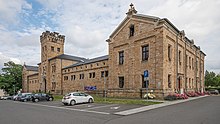
The stables

Friedenstein Castle

Ducal Museum, Art Museum Foundation Friedenstein Castle Gotha
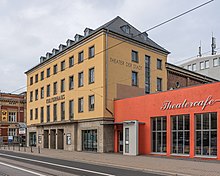
Culture house and theatre café Gotha
Search within the encyclopedia